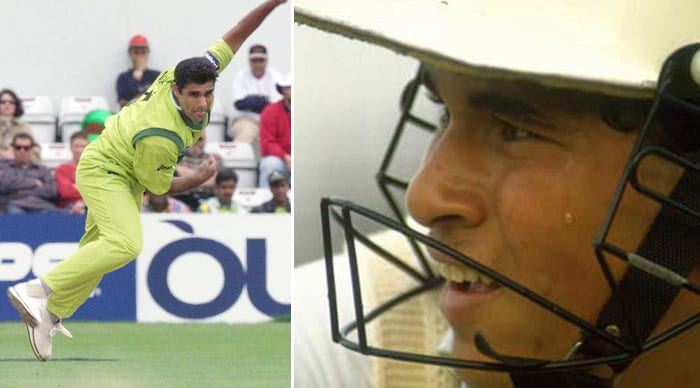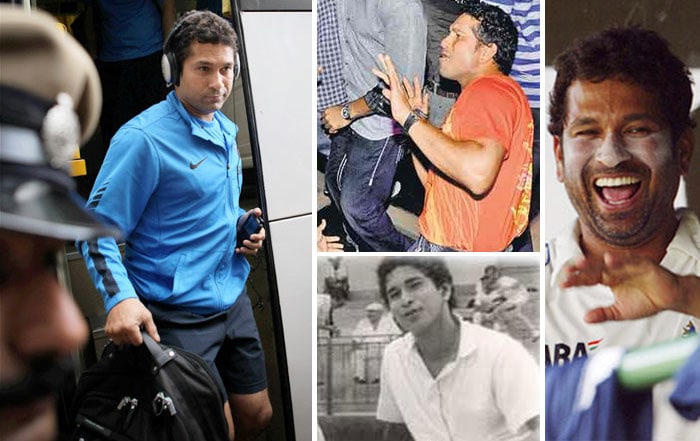
Did you know that Sachin Tendulkar cannot live without his iPod? On the cricket maestro's 37th birthday, we dug out some not-so well known facts about Tendlya.

Despite attaining his iconic status, Sachin's feet are firm on the ground. His simplicity has perhaps been his greatest virtue.
Tendulkar sponsors 200 underprivileged children every year through Apnalaya, a Mumbai-based NGO associated with his mother-in-law, Annaben Mehta.

Sachin's agility is not restrained just to cricket. He was taught swimming in some half an hour by Manoj Prabhakar on the 1990 tour to England. The ambidextrous cricketer also likes to play table-tennis and carries his own racquet on tours. He is also fond of adventure sports.

Sachin attended the MRF Pace Foundation to train as a fast bowler, but Australian fast bowler Dennis Lillee suggested the small-framed prodigy to focus on his batting instead. The suggestion further moulded the cricketing path that was undertaken by Sachin. After his family moved closer to Shivaji Park in Bombay, Sachin's game began to improve.
At the age of twelve and thirteen, he was practicing and playing school matches for a total of twelve hours a day on some days. His passion for excellence was relentless. He once played fifty-four matches in a row. When he was 14, Indian batting legend Sunil Gavaskar gave him a pair of his own ultra light pads.

During practice sessions, Tendulkar's coach and mentor, Ramakant Achrekar used to put a one-Rupee-coin on top of the stumps, and the bowler who dismissed Tendulkar used to get the coin. If Tendulkar passed the whole session without getting dismissed, the coach used to give him the coin. The 13 coins won by Tendulakar paved way for bigger, better awards and prizes but those 13 coins are still priceless for the Master Blaster.

He started showing signs of what was to come in the years that followed.
Sachin Tendulkar, 14, compiled a 664-run unbroken partnership with his childhood friend Vinod Kambli for Shardashram Vidyamandir against St Xavier's at Azad Maidan. The two kept batting ignoring coach's signal. They later revealed that they got scolding of their lives after the game. Tendulkar scored an unbeaten 326 and it remained the highest partnership recorded in any form of cricket, until in November 2006 two schoolboys from Hyderabad overtook the record with an unbeaten 721-run partnership.

On 11 December 1988, aged just 15 years and 232 days, Tendulkar scored 100 not out in his debut first-class match for Bombay against Gujarat, making him the youngest Indian to score a century on first-class debut. He is infact the only player to score a century in all three of his Ranji Trophy, Duleep Trophy and Irani Trophy debuts.

At sixteen, Sachin was picked to play his first Test match for India against Pakistan. His father signed the papers for him, because Sachin was too young.

On the final day of his first Test series, he was hit on the nose by a bouncer by Waqar Younis who also made his debut in the same series. Sachin fell down but got up again to play. He declined medical assistance and continued to bat even as blood gushed from his nose. He went on to score 57 runs in the match.

On 24 May 1995, Sachin married Anjali, a paediatrician and daughter of Gujarati industrialist Anand Mehta, elder to him by six years.
His friends say that Sachin and Anjali met through mutual friends and fell in love. The year of marriage served to be a lucky one for Tendulkar, in that very year, he signed a five-year contract worth Rs 31.5 crore with WorldTel, which made him the richest cricketer in the world.

Ignorant about cricket when she first started dating Sachin, Anjali said she read up everything about the game soon after but the man himself didn't like discussing the sport with her.
During their courtship, Tendulkar had to come in disguise, wearing a beard and spectacles, to watch a movie with Anjali and her friends but the plan went haywire very soon and the couple had to leave the hall midway through the film.

Tendulkar is blessed with two children. His daughter Sara was born on 12 October 1997 and his son, Arjun on 24 September 1999. Despite all the fame and adulations, Sachin does not allow anyone to intrude and intervene in his private life.

After India's disappointing stint at the 1999 World Cup, Sachin was reappointed as the Indian captain against his consent. Bowing down before the greater good of the team, Sachin had to accept the proposition. Sachin Tendulkar, the captain, salvaged the nation's pride as India defeated World Champions Australia on their own soil. However, Tendulkar resigned within a year itself in 2000 allowing Sourav Ganguly to take over. The same trend followed as immediately after stepping down, Tendulkar was his usual firey self again.

In 2002, while commemorating Sachin Tendulkar's feat of equalling Don Bradman's 29 centuries in Test Cricket, automotive giant Ferrari invited Sachin Tendulkar to its paddock in Silverstone on the eve of the British Grand Prix (23 July 2002) to receive a Ferrari 360 Modena from the legendary F1 racer Michael Schumacher. India's then finance minister Jaswant Singh said the customs duty imposed on the car as a measure to applaud his feat but political and social activists protested the waiver and filed PIL in the Delhi High Court. With the controversy snowballing, Sachin offered to pay the customs duty of Rs 1.13 Crores or 120% on the car value of Rs 75 Lakhs and the tab was finally picked up by Ferrari.

The unstoppable Sachin crossed 17,000 ODI runs in 2009 during the India-Australia ODI Series, outdoing his initial record only to re-establish himself as the highest run scorer in ODI cricket. Tendulkar also achieved his personal best against Australia and described it as one of his best innings but said it could have been better had India won the match.

The man who gave the term perfection a new name emerged unscathed from every upheaval. Sachin Tendulakr knew best how to perfect perfection. In February this year, in a stunning display in Gwalior Tendulkar became the first male player to score 200 in a single innings in a One-Day International. That too off just 147 deliveries. No wonder the iconic player has been referred to as God by millions of Indians.

Sachin's greatest hobby, according to his close friends, is music. He has a vast collection of western pop and serious music and spends every available leisure hour listening to his favourite artists.
Source : http://cricket.ndtv.com
photos from : http://cricket.ndtv.com


















 Did you know that Sachin Tendulkar cannot live without his iPod? On the cricket maestro's 37th birthday, we dug out some not-so well known facts about Tendlya.
Did you know that Sachin Tendulkar cannot live without his iPod? On the cricket maestro's 37th birthday, we dug out some not-so well known facts about Tendlya. Despite attaining his iconic status, Sachin's feet are firm on the ground. His simplicity has perhaps been his greatest virtue.
Despite attaining his iconic status, Sachin's feet are firm on the ground. His simplicity has perhaps been his greatest virtue. Sachin's agility is not restrained just to cricket. He was taught swimming in some half an hour by Manoj Prabhakar on the 1990 tour to England. The ambidextrous cricketer also likes to play table-tennis and carries his own racquet on tours. He is also fond of adventure sports.
Sachin's agility is not restrained just to cricket. He was taught swimming in some half an hour by Manoj Prabhakar on the 1990 tour to England. The ambidextrous cricketer also likes to play table-tennis and carries his own racquet on tours. He is also fond of adventure sports. Sachin attended the MRF Pace Foundation to train as a fast bowler, but Australian fast bowler Dennis Lillee suggested the small-framed prodigy to focus on his batting instead. The suggestion further moulded the cricketing path that was undertaken by Sachin. After his family moved closer to Shivaji Park in Bombay, Sachin's game began to improve.
Sachin attended the MRF Pace Foundation to train as a fast bowler, but Australian fast bowler Dennis Lillee suggested the small-framed prodigy to focus on his batting instead. The suggestion further moulded the cricketing path that was undertaken by Sachin. After his family moved closer to Shivaji Park in Bombay, Sachin's game began to improve. During practice sessions, Tendulkar's coach and mentor, Ramakant Achrekar used to put a one-Rupee-coin on top of the stumps, and the bowler who dismissed Tendulkar used to get the coin. If Tendulkar passed the whole session without getting dismissed, the coach used to give him the coin. The 13 coins won by Tendulakar paved way for bigger, better awards and prizes but those 13 coins are still priceless for the Master Blaster.
During practice sessions, Tendulkar's coach and mentor, Ramakant Achrekar used to put a one-Rupee-coin on top of the stumps, and the bowler who dismissed Tendulkar used to get the coin. If Tendulkar passed the whole session without getting dismissed, the coach used to give him the coin. The 13 coins won by Tendulakar paved way for bigger, better awards and prizes but those 13 coins are still priceless for the Master Blaster. He started showing signs of what was to come in the years that followed.
He started showing signs of what was to come in the years that followed. On 11 December 1988, aged just 15 years and 232 days, Tendulkar scored 100 not out in his debut first-class match for Bombay against Gujarat, making him the youngest Indian to score a century on first-class debut. He is infact the only player to score a century in all three of his Ranji Trophy, Duleep Trophy and Irani Trophy debuts.
On 11 December 1988, aged just 15 years and 232 days, Tendulkar scored 100 not out in his debut first-class match for Bombay against Gujarat, making him the youngest Indian to score a century on first-class debut. He is infact the only player to score a century in all three of his Ranji Trophy, Duleep Trophy and Irani Trophy debuts. At sixteen, Sachin was picked to play his first Test match for India against Pakistan. His father signed the papers for him, because Sachin was too young.
At sixteen, Sachin was picked to play his first Test match for India against Pakistan. His father signed the papers for him, because Sachin was too young. On the final day of his first Test series, he was hit on the nose by a bouncer by Waqar Younis who also made his debut in the same series. Sachin fell down but got up again to play. He declined medical assistance and continued to bat even as blood gushed from his nose. He went on to score 57 runs in the match.
On the final day of his first Test series, he was hit on the nose by a bouncer by Waqar Younis who also made his debut in the same series. Sachin fell down but got up again to play. He declined medical assistance and continued to bat even as blood gushed from his nose. He went on to score 57 runs in the match. On 24 May 1995, Sachin married Anjali, a paediatrician and daughter of Gujarati industrialist Anand Mehta, elder to him by six years.
On 24 May 1995, Sachin married Anjali, a paediatrician and daughter of Gujarati industrialist Anand Mehta, elder to him by six years. Ignorant about cricket when she first started dating Sachin, Anjali said she read up everything about the game soon after but the man himself didn't like discussing the sport with her.
Ignorant about cricket when she first started dating Sachin, Anjali said she read up everything about the game soon after but the man himself didn't like discussing the sport with her. Tendulkar is blessed with two children. His daughter Sara was born on 12 October 1997 and his son, Arjun on 24 September 1999. Despite all the fame and adulations, Sachin does not allow anyone to intrude and intervene in his private life.
Tendulkar is blessed with two children. His daughter Sara was born on 12 October 1997 and his son, Arjun on 24 September 1999. Despite all the fame and adulations, Sachin does not allow anyone to intrude and intervene in his private life. After India's disappointing stint at the 1999 World Cup, Sachin was reappointed as the Indian captain against his consent. Bowing down before the greater good of the team, Sachin had to accept the proposition. Sachin Tendulkar, the captain, salvaged the nation's pride as India defeated World Champions Australia on their own soil. However, Tendulkar resigned within a year itself in 2000 allowing Sourav Ganguly to take over. The same trend followed as immediately after stepping down, Tendulkar was his usual firey self again.
After India's disappointing stint at the 1999 World Cup, Sachin was reappointed as the Indian captain against his consent. Bowing down before the greater good of the team, Sachin had to accept the proposition. Sachin Tendulkar, the captain, salvaged the nation's pride as India defeated World Champions Australia on their own soil. However, Tendulkar resigned within a year itself in 2000 allowing Sourav Ganguly to take over. The same trend followed as immediately after stepping down, Tendulkar was his usual firey self again. In 2002, while commemorating Sachin Tendulkar's feat of equalling Don Bradman's 29 centuries in Test Cricket, automotive giant Ferrari invited Sachin Tendulkar to its paddock in Silverstone on the eve of the British Grand Prix (23 July 2002) to receive a Ferrari 360 Modena from the legendary F1 racer Michael Schumacher. India's then finance minister Jaswant Singh said the customs duty imposed on the car as a measure to applaud his feat but political and social activists protested the waiver and filed PIL in the Delhi High Court. With the controversy snowballing, Sachin offered to pay the customs duty of Rs 1.13 Crores or 120% on the car value of Rs 75 Lakhs and the tab was finally picked up by Ferrari.
In 2002, while commemorating Sachin Tendulkar's feat of equalling Don Bradman's 29 centuries in Test Cricket, automotive giant Ferrari invited Sachin Tendulkar to its paddock in Silverstone on the eve of the British Grand Prix (23 July 2002) to receive a Ferrari 360 Modena from the legendary F1 racer Michael Schumacher. India's then finance minister Jaswant Singh said the customs duty imposed on the car as a measure to applaud his feat but political and social activists protested the waiver and filed PIL in the Delhi High Court. With the controversy snowballing, Sachin offered to pay the customs duty of Rs 1.13 Crores or 120% on the car value of Rs 75 Lakhs and the tab was finally picked up by Ferrari. The unstoppable Sachin crossed 17,000 ODI runs in 2009 during the India-Australia ODI Series, outdoing his initial record only to re-establish himself as the highest run scorer in ODI cricket. Tendulkar also achieved his personal best against Australia and described it as one of his best innings but said it could have been better had India won the match.
The unstoppable Sachin crossed 17,000 ODI runs in 2009 during the India-Australia ODI Series, outdoing his initial record only to re-establish himself as the highest run scorer in ODI cricket. Tendulkar also achieved his personal best against Australia and described it as one of his best innings but said it could have been better had India won the match. The man who gave the term perfection a new name emerged unscathed from every upheaval. Sachin Tendulakr knew best how to perfect perfection. In February this year, in a stunning display in Gwalior Tendulkar became the first male player to score 200 in a single innings in a One-Day International. That too off just 147 deliveries. No wonder the iconic player has been referred to as God by millions of Indians.
The man who gave the term perfection a new name emerged unscathed from every upheaval. Sachin Tendulakr knew best how to perfect perfection. In February this year, in a stunning display in Gwalior Tendulkar became the first male player to score 200 in a single innings in a One-Day International. That too off just 147 deliveries. No wonder the iconic player has been referred to as God by millions of Indians. Sachin's greatest hobby, according to his close friends, is music. He has a vast collection of western pop and serious music and spends every available leisure hour listening to his favourite artists.
Sachin's greatest hobby, according to his close friends, is music. He has a vast collection of western pop and serious music and spends every available leisure hour listening to his favourite artists.
















 ____________
____________ __
__



